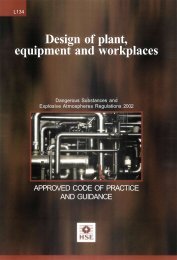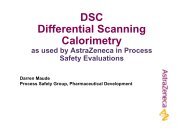Designing and operating safe chemical reaction processes HSG143
Designing and operating safe chemical reaction processes HSG143
Designing and operating safe chemical reaction processes HSG143
You also want an ePaper? Increase the reach of your titles
YUMPU automatically turns print PDFs into web optimized ePapers that Google loves.
Health <strong>and</strong> SafetyExecutive52 To additionally illustrate the effect of scale up on the heat balance consider anexothermic <strong>reaction</strong> where the heat of <strong>reaction</strong> is -416 kJ kg -1 of reactant mass;the specific heat of the <strong>reaction</strong> mass is 1.26 kJ kg -1 K -1 ; <strong>and</strong> the <strong>reaction</strong> is carriedout over one hour with a jacket-to-contents temperature differential of 80 o C. Thedifferences between laboratory scale <strong>and</strong> plant scale are:Laboratory scalePlant scale(100 ml) (4500 litres)Heat loss (W kg -1 K -1 ) 2.3 0.04Cooling rate (K hr -1 ) 520 9Adiabatic temperature rise (K) 330 330(See paragraph 79)Result No exotherm seen Possible runawayAn explosion occurred during the manufacture of a phenolic resin by a phenolformaldehyde<strong>reaction</strong> catalysed by caustic soda in a 5.9 m 3 <strong>reaction</strong> vessel. Theexplosion ruptured the vessel <strong>and</strong> caused considerable damage to the building.The incident occurred because of insufficient cooling capacity on scaling up theprocess. The <strong>reaction</strong> process was scaled up from 2.3 m 3 to 5.9 m 3 withouttaking due account of the reduction in vessel cooling capacity. This resulted inan increased <strong>reaction</strong> temperature that caused a runaway exothermic <strong>reaction</strong>.The <strong>safe</strong> <strong>operating</strong> envelope53 What the designer is trying to achieve is a controlled <strong>chemical</strong> <strong>reaction</strong> processthat avoids a hazardous situation from occurring. The <strong>safe</strong> <strong>operating</strong> envelopedefines the boundaries that contain the controlled <strong>reaction</strong>.54 It is inherently <strong>safe</strong>r if you develop <strong>processes</strong> with wide <strong>safe</strong> <strong>operating</strong>envelopes. These are less sensitive to variations in critical <strong>operating</strong> parameters.For example, controlling your process within a very small temperature b<strong>and</strong> toavoid hazardous conditions means that the process has a narrow <strong>safe</strong> <strong>operating</strong>envelope. A process with a larger temperature b<strong>and</strong> will have a wider <strong>safe</strong><strong>operating</strong> envelope.55 Discussion about the determination of the <strong>safe</strong> <strong>operating</strong> envelope occurs inparagraphs 123-125.<strong>Designing</strong> <strong>and</strong> <strong>operating</strong> <strong>safe</strong> <strong>chemical</strong> <strong>reaction</strong> <strong>processes</strong> Page 14 of 64










